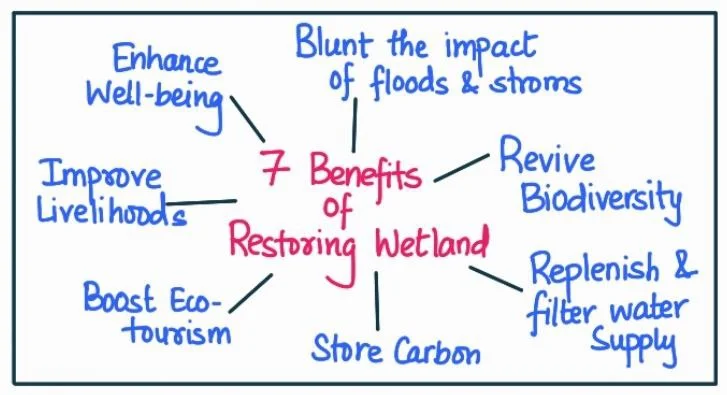Answer:
Approach:
- Introduction: Start your answer with the role of wetland.
- Body: Discuss the Ramsar Concept of ‘Wise Use’ in Wetland Conservation.
- Conclusion: Conclude your answer summary of the answer.
|
Introduction:
Wetlands are areas where water is the primary factor controlling the environment and the associated plant and animal life. They are characterized by the presence of water, whether permanently or seasonally, and can include marshes, swamps, bogs, and mangroves. Wetlands play a crucial role in maintaining biodiversity, regulating water flow, improving water quality, and providing habitat for various species.
Body:
- The Ramsar Concept of ‘Wise Use’ in Wetland Conservation:
- The Ramsar Convention, signed in Ramsar, Iran, in 1971, is an international treaty aimed at conserving wetlands and promoting their sustainable use. The central concept of the Ramsar Convention is the ‘wise use’ of wetlands. The ‘wise use’ approach emphasizes the conservation and sustainable utilization of wetland resources, taking into account ecological, economic, cultural, and social aspects.
- The ‘wise use’ principle acknowledges that wetlands can provide numerous benefits to human communities while ensuring their long-term ecological sustainability. It involves promoting actions that maintain the ecological character of wetlands, while also addressing the needs of local communities, promoting sustainable livelihoods, and considering cultural values.

- Examples of Ramsar Sites in India:
- Chilika Lake, Odisha: Chilika Lake, located on the east coast of India, is the largest brackish water lagoon in Asia. It is home to a rich variety of plant and animal species, including rare and endangered species like the Irrawaddy dolphin and the blackbuck. The lake serves as an essential habitat for migratory birds and supports the livelihoods of local communities through fishing and tourism.
- Keoladeo National Park, Rajasthan: Keoladeo National Park, formerly known as Bharatpur Bird Sanctuary, is a famous avian habitat in Rajasthan. It attracts thousands of migratory birds, including Siberian cranes, every year. The wetland ecosystem of Keoladeo plays a vital role in supporting these migratory birds and acts as an important breeding ground for resident species as well.
Conclusion:
The Ramsar Convention emphasizes the preservation and responsible utilization of wetlands. Two notable Ramsar sites in India are Chilika Lake in Odisha and Keoladeo National Park in Rajasthan.
